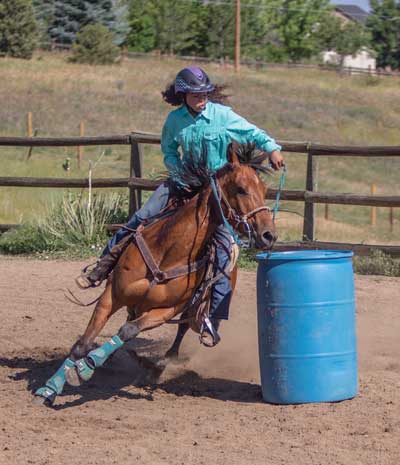
You’ve been running barrels for a while now: You know the pattern. Your turns are solid. Your seat is stable. But you just aren’t going fast enough! If that sounds familiar, then this guide is for you. We’ll walk you through the steps to add acceleration and improve your barrel racing runs.
Play Detective
The first step is to make sure there isn’t a good reason your horse or pony doesn’t go all out. Talk to your vet to make sure the diet you’re feeding your horse is what’s best for his needs and performance level. Also ask your vet about any soundness or health concerns. If your horse isn’t feeling his best, then he won’t perform his best.

Self-Evaluation
You don’t want to try to add speed until your barrel runs are otherwise solid, meaning you have good control and consistent turns. You also need to make sure you have a secure seat and aren’t losing your balance during any part of the run.
When you want your horse to speed up, assume a slightly forward position. Your legs should stay underneath you with your heels down. Your upper body should come slightly forward, as will your hands.
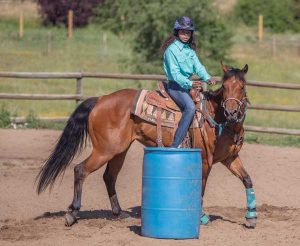
Keep your hands steady, and make sure you’re not accidentally pulling or bumping your horse’s mouth as you ask for speed. Look where you want to go, and free your mind of any fear.
Many horses will need encouragement in the form of squeezing or tapping from your legs, but avoid overly aggressive kicking. Spurs should only be used by experienced riders with very steady legs and an understanding of how to use them effectively, which varies depending on the type of spur chosen. (Always work with a trainer or instructor to determine if spurs are right for you and to introduce them to your horse.)
Getting in Shape
Your horse needs to be in good physical shape to perform at his fastest. Ideally, you’ll want to ride your horse most days, with one or two days off per week. If you do a more rigorous workout one day, then do a light or more moderate workout the next time you ride.
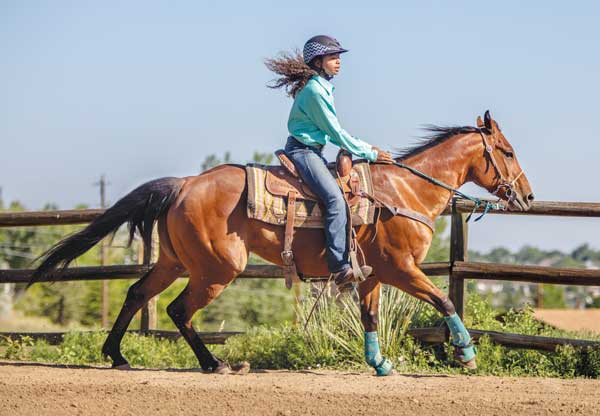
While it’s important to practice the barrel pattern, you don’t want to overdo it. For one, the tight turns are hard on your horse’s legs and joints. Secondly, you and your horse will both get bored. Don’t practice the cloverleaf every workout—instead, mix it up.
Exercises for Improving Your Barrel Racing Runs
Exercises inside and outside the ring will keep things fresh and help your horse stay in shape. Here are a few exercises that you can try.
◆ Free Run: Letting your horse open up outside the arena can help him learn to speed up. If there’s an open area with good footing, and you have proper control and feel safe, you can practice letting your horse fo into a full gallop without interference. Do not gallop toward the barn, however, as many horses stop listening and may become out of control.
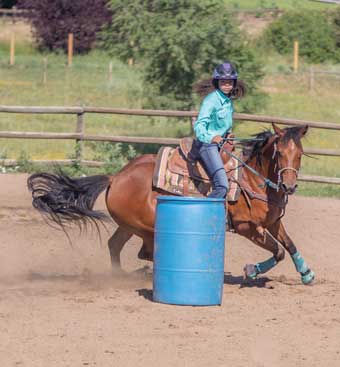
Once he’s gone a ways (further than the final barrel to home), you can let him rest as a reward for his hard work and give him a pat on the neck and some encouraging words.
◆ Trail Riding: Trail riding is always a good break from the arena. Doing some hill work—just at the walk!—can help build up muscle. Long trotting on good footing can also help condition your horse.
◆ Free Rein: Inside the arena, you can try an exercise where you keep your horse in a trot but don’t interfere with his mouth. Keep your hands on the reins but keep them low and loose. Let him go wherever he wants to in the arena as long as it’s safe.
The idea is to maintain speed without interfering with his mouth. Once this is comfortable, you can try it at faster speeds. This will also help you become more aware of your hands and seat.
◆ Run and Rest: With the pattern set up, practice running your horse past the barrel to the arena fence and then resting. You can do this with each of the three barrels. It can help your horse open up without worrying about an upcoming tight turn.
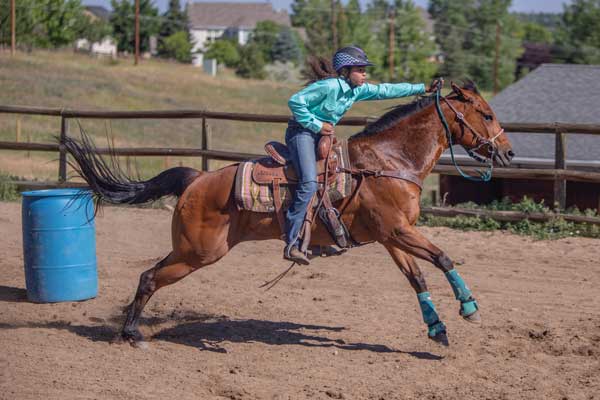
Go For It!
All horses can improve their runs. However, keep in mind that not all horses are optimally built or bred for speed. Some horses have more of an ability or desire to run barrels. But with some good detective work, conditioning and exercises, you can still shave seconds off the clock.
May you turn and burn with the best of them!
Thanks to Sadie Jackson and TC for demonstrating these exercises! Sadie Jackson is 12 years old and lives in Colorado. Last year, Sadie joined the nation’s best cowboys and cowgirls in Las Vegas, Nev., for the Junior National Finals Rodeo where she ran barrels. So far in 2019, she’s won multiple national titles in youth barrels and will be heading back to the Junior World Finals at the National Finals Rodeo in December. All these accomplishments wouldn’t be possible without the help of her American Quarter Horse mare Sundae Frost (“TC”). TC stands 14.2 hands and is full of speed, sass and sweetness. I addition to being a busy rider, Sadie is an honor roll student and participates in leadership team, track and choir. She also spends time giving back to the community through various events and groups, including volunteer work at McNicholas Miniatures Therapy Horses.
This article on improving your barrel racing runs originally appeared in the September/October 2019 issue of Young Rider magazine. Click here to subscribe!


